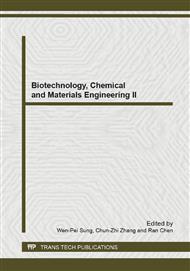p.351
p.355
p.363
p.367
p.371
p.377
p.381
p.385
p.389
Experimental Research about the Application of ER Elastomer in the Shock Absorber
Abstract:
When the Electrorheological elastomer (ERE) is embedded into intelligence structure system, the structure damping and stiffness of the system can be changed quickly and reversibly under an external electric field. Thus, the application of the Electrorheological elastomer in the active and passive hybrid control of structural vibration has already attracted people's wide attention. In this paper, three types of ER elastomer were prepared based on barium titanate, starch, then the microstructure of ER elastomer was observed and the mechanical properties were analyzed; a shear mode ERE shock absorber was designed, the vibration response performance of which was experimentally evaluated under various excitation frequency with or without the applied field. The experimental results showed that the damping and stiffness of the shock absorber could be modified with a changing external electric field, whose macro-features was that the damping coefficient increased with the increase of the electric field, and the damping effect in the high frequency was better than in the low frequency.
Info:
Periodical:
Pages:
371-376
Citation:
Online since:
January 2013
Authors:
Keywords:
Price:
Сopyright:
© 2013 Trans Tech Publications Ltd. All Rights Reserved
Share:
Citation:


